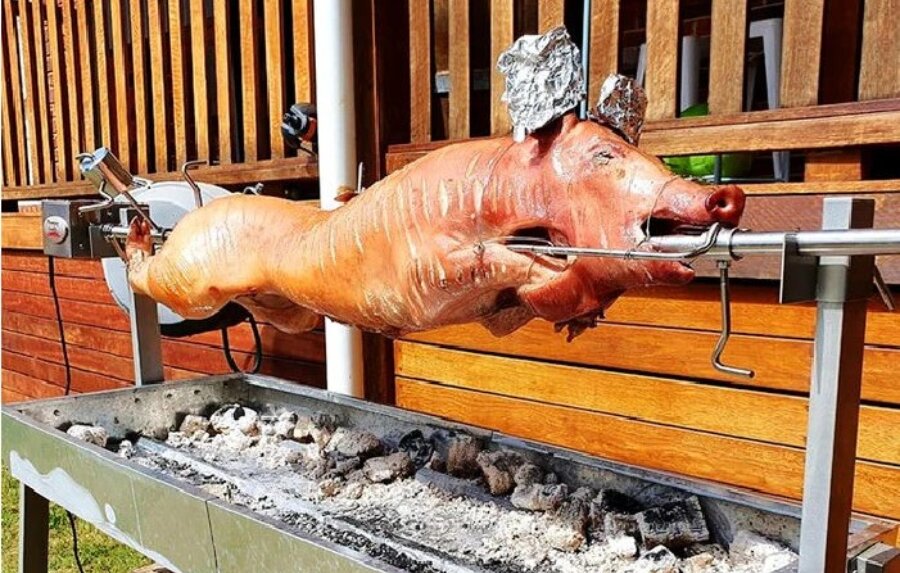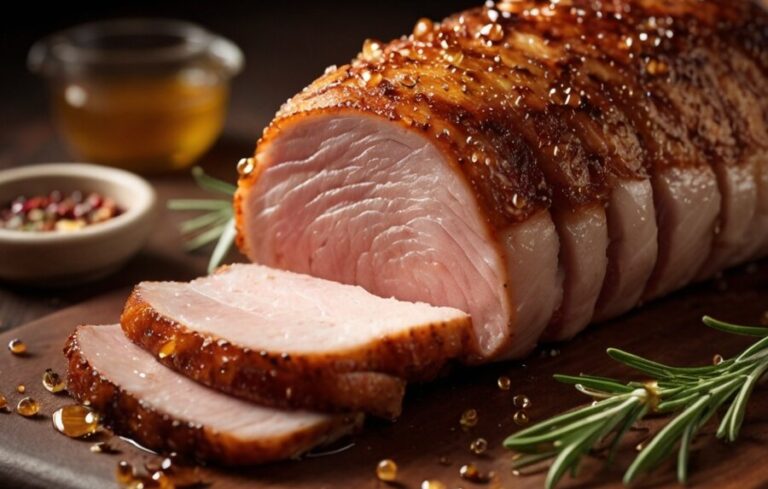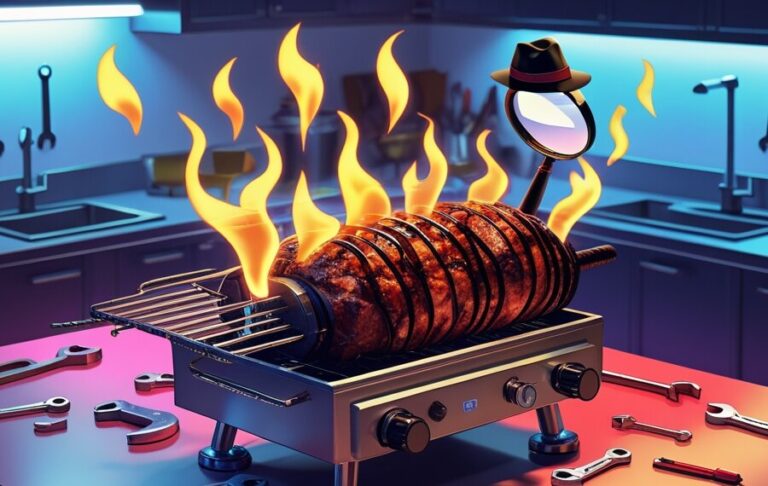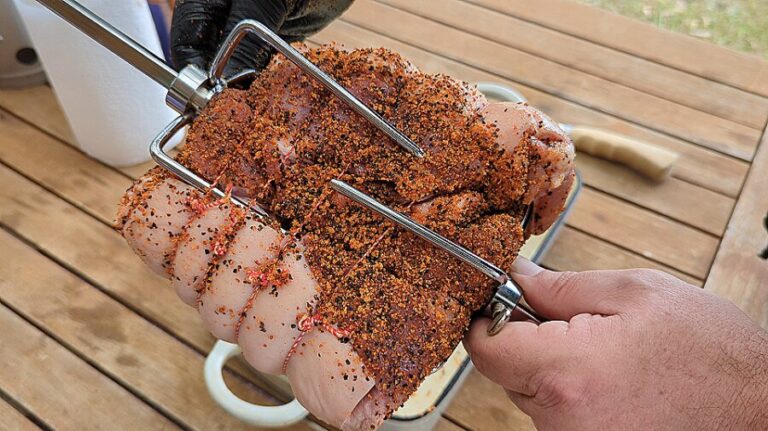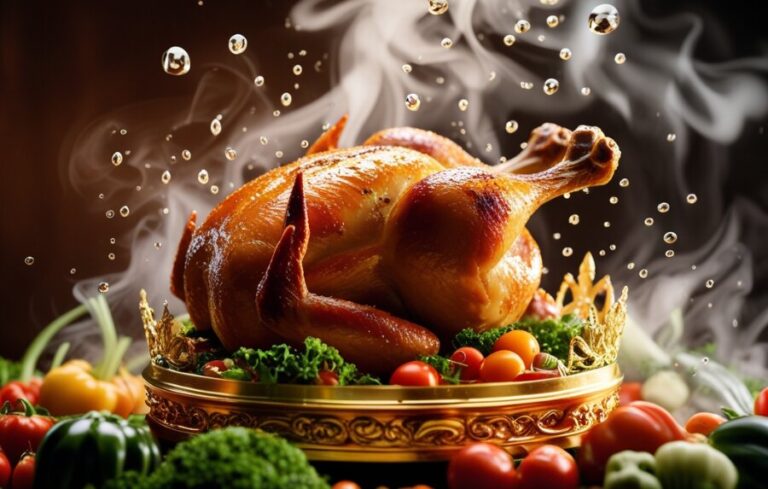Our evaluations and product assessments are conducted using a thorough and unbiased approach. Should you choose to buy any items through our provided links, we might receive a commission Read our disclosures.
Getting Ready for Spit-Roasting
Ready to tackle the whole pig rotisserie? Hold on to your aprons! Smooth sailing’s all about picking the right gear and jazzing up that pig with some killer flavors.
The Right Gear
When you’re roasting a whole hog, your equipment can make or break it. Trust me, you don’t want to skimp here. I’m all in for a rotisserie built for the job, like the Meadow Creek whole hog roasters. They keep that heat steady for hours, which is super important for even cooking. Plus, you can add an electronic temperature controller to keep things on track without babysitting the roast.
Now, there are a bunch of ways to do this—burying the pig in the ground, motorized rotisserie, or even an old-school hand-crank spit. But Meadow Creek’s setup is awesome because you don’t have to keep turning the meat or worry about those pesky grease fires.
| Equipment Type. | Why It’s Great |
|---|---|
| Meadow Creek Roaster | Steady heat, optional electronic controller |
| Motorized Rotisserie | Less manual work, even cooking |
| Hand-Crank Spit | Traditional, manual control |
Flavor Magic
Alright, let’s talk seasoning. This can really make your pig sing. My method’s got a few parts: brining, injecting, and a killer dry rub.
First up, brining. I mix up some salt, sugar, and spices to keep that pig juicy and flavorful. After brining, I go big on injecting. Apple juice, dry rub, and apple cider vinegar go right into the hams and shoulders for that extra wow factor.
Then slap on that dry rub. Be generous with it—inside and out. During cooking, I mop the pig every 45 minutes with a mix of Worcestershire sauce, lemon juice, and butter. This keeps it juicy and adds flavor layers. Some folks like to wrap their roast in foil or roasting bags to lock in moisture, too.
| Seasoning Method | Why It Rocks |
|---|---|
| Brining | Packs in moisture and flavor |
| Injection | Adds tenderness and deep flavor |
| Dry Rub | Boosts overall taste |
| Mop Mix | Keeps meat moist and flavorful |
Getting ready for a whole pig roast means smart gear choices and rocking those seasoning steps. Follow these tips, and you’re on your way to a lip-smacking rotisserie feast. Don’t forget to check out my top rotisserie pork recipes for more flavor ideas!
Rotisserie Cooking Process
When I think about the magic of rotisserie cooking, it’s the technique of indirect heat that steals the show. This method is key to getting that juicy, flavorful meat we all crave.
Indirect Heat Cooking
Indirect heat cooking means not letting the heat source touch the meat directly. For a whole pig rotisserie, I usually set up a firebox at the bottom using charcoal, wood chips, electric elements, or gas burners. Once the setup is ready, I secure the spit and let the meat cook slowly over low, indirect heat for several hours. This method lets every bite turn out mouthwateringly tender.
Here’s a quick overview of how I prepare the firebox:
| Heating Element | Description |
|---|---|
| Charcoal | Gives that classic smokey flavor; keep an eye on it though. |
| Wood Chips | Adds a rich depth; mix with charcoal if you like. |
| Electric Elements | Easy for precise control, no guesswork here. |
| Gas Burners | Easiest to manage; perfect for newbies. |
I also find that basting the meat with a liquid marinade or wrapping it in foil helps keep it juicy as it cooks. Cooking veggies like potatoes and bell peppers alongside the meat? Chef’s kiss – it makes for a complete meal and the flavors meld beautifully (r-grill).
Keeping an Eye on Things
Another crucial part of great rotisserie cooking is monitoring and adjusting the process. Since we’re using indirect heat, keeping an eye on the meat’s internal temperature is a must. That’s where a good thermometer comes in handy.
During cooking, I’ll periodically check the meat’s temp and the status of the heat source. If there’s a drop in temperature or if the fire isn’t going as strong as it should, I tweak things as needed. Here’s a table that shows the ideal internal temperatures I aim for different cuts of pork:
| Pork Cut | Ideal Internal Temperature (°F) |
|---|---|
| Whole Pig | 190 – 205 |
| Pork Loin | 145 – 160 |
| Pork Shoulder | 190 – 205 |
Maintaining steady heat is like a balancing act, but the rewards are absolutely worth it. Rotisserie cooking gives you delicious, restaurant-quality results without constantly worrying about overcooking or flare-ups. It’s my go-to for enjoying outdoor cooking at its best. For more specific tips and recipes, check out my sections on rotisserie pork loin and rotisserie pork shoulder.

Timing and Temperature
Nailing the timing and temperature is the secret sauce to roasting a whole pig perfectly. Trust me, I’ve been in the pig roast trenches, and these two factors can make or break your masterpiece.
Cooking Duration
When I plan my pig roasts, I’ve learned the cooking time can be a bit of a moving target. It depends on the pig’s size and how you’re cooking it. For a pig around 150 pounds, you’re looking at about 8 to 10 hours on a spit. And don’t neglect those coals – they can turn that crackling skin into a burnt mess if you’re not careful.
Here’s a cheat sheet for cooking times based on pig size:
| Pig Weight (lbs) | Cooking Duration (hours) |
|---|---|
| 50 | 4-5 |
| 100 | 6-7 |
| 150 | 8-10 |
| 200 | 10-12 |
If you’re using a smokehouse, my go-to is 180°F overnight for a 150-pound pig. That way, it cooks slow and even. If it hits 170°F internally before you’re ready to serve, just hold it there. When you’re close to chowing down, crank it up to 200°F or 225°F to finish things off.
Internal Temperature Check
Keeping an eye on the internal temperature is non-negotiable to make sure your pig is cooked all the way and bursting with flavor. I always aim for 170°F internally. That sweet spot ensures the meat is cooked but still juicy.
A good meat thermometer is your best buddy here. Stick it into the thickest part of the shoulder or thigh, but dodge the bones – they can mess up your reading. Here’s a quick guide for internal temps:
| Type of Meat | Safe Internal Temperature (°F) |
|---|---|
| Whole Pig | 170 |
| Pork Tenderloin | 145 |
| Pork Shoulder | 190-205 |
Want to spice things up? Try some rotisserie pork recipes while you’re at it. Different flavors can take your roast to the next level. Remember, timing and temperature are the dynamic duo for a killer whole pig rotisserie!
Slicing and Plating
Getting your pig roast from spit to plate is just as important as cooking it right. Here’s my two cents on letting it rest and carving it up perfectly to make every mouthful unforgettable.
Chill Time
Once the pig’s done cooking, take a breather instead of diving right in with the knife. Letting it rest (about 30 minutes to 1 hour) helps those tasty juices spread out evenly, turning your meat into a juicy delight. Trust me, this little wait makes all the difference in flavor and moisture.
To keep the pig warm while it rests, cover it loosely with some foil. This keeps in the heat but lets enough steam escape, keeping that skin crackly and perfect.
Carving Hacks
The idea of carving a whole roasted pig can feel a bit like rocket science, but stick with me—it’s simpler than you think. Here’s my go-to method:
Get Your Gear: Grab a sharp knife and a hefty cutting board. Seriously, a good knife is gold here.
Kickoff with the Shoulders: I always start with the shoulders. If your pig’s cooked to about 180°F, this meat should just fall off the bone. You might need a fork to help pull it apart.
Hit the Ham Next: Move on to the ham and slice it to your preferred thickness. Leaving the skin on adds a great crunch.
Unveil the Belly: After the ham, cut along the belly to reveal the juicy meat inside, especially if you followed my trick of stuffing the pig with whole chickens.
Time to Serve: Serve up your juicy roast with some classic sides like coleslaw or baked beans. Toss in a few sauce options—vinegar-based or traditional barbecue sauce works great.
Scaling for Quantity Made Easy
You’re hosting a pig roast, and you want everyone to go home stuffed and happy. Here’s the lowdown on how I plan for the perfect BBQ, ensuring everyone gets their fair share without going overboard.
Serving Size Estimation
One of the tricks to pulling off a successful pig roast is nailing those serving sizes. Here’s a quick cheat sheet for boneless pork:
| Serving Type | Servings per Pound |
|---|---|
| Light Eaters | 4 |
| Average Appetites | 3 |
| Big Eaters | 2 |
| Adults (suggested) | 2.5 |
So, if you’re prepping for a crew of adults, figure around 2.5 servings per pound. Got 40 guests? You’re looking at about 16 pounds of boneless pork. Pretty simple when you break it down, right? You can even double-check with Michigan State University Extension.
Cooking times might vary, so don’t stress if things aren’t exact. Proper prep and planning make a world of difference. Toss in some tasty rotisserie pork recipes and keep an eye on the perfect rotisserie pork temperature. Get it right, and you’ll be the host everyone talks about—for all the right reasons.
Enjoy the feast, and here’s to making memories with great food and great company!
Spice Up Your Pig Roast
Wanna take your pig roast to the next level? Throw in some tasty side dishes, lip-smacking sauces, and even sneak in some veggies on that rotisserie. Buckle up for a food adventure!
Delicious Sides and Sauces
When I’m at it with a whole pig roast, I never skip the classic BBQ sides. Here are my all-time faves:
- Coleslaw – Crunchy, creamy goodness. It freshens up every bite.
- Mac and Cheese – Because who doesn’t love cheesy comfort food?
- Potato Salad – Cool and tangy, a must-have.
- Baked Beans – Sweet, smoky, and perfect.
And juices aren’t just for breakfast. Making sauces from scratch can elevate your roast. Try these out:
- Carolina Vinegar Sauce – Tangy and sharp, it cuts through the richness.
- Habanero Cola Sauce – A spicy-sweet kick that’ll wake up your taste buds.
If you’re looking for step-by-step guides, check out our rotisserie pork recipes.
| Side Dish | Flavor Vibe |
|---|---|
| Coleslaw | Crunchy and creamy |
| Mac and Cheese | Cheesy and indulgent |
| Potato Salad | Cool and tangy |
| Baked Beans | Sweet and smoky |
Pro Tip: Serve the pork in buns for an easy fix. Rye or whole wheat buns are sturdy choices. They won’t fall apart with all that juicy goodness (Michigan State University Extension). Trust me, you’ll thank me later.
Veggie Magic on the Spit
Your pig ain’t the only star of the show. Adding veggies can bring in colors and flavors you didn’t even know you were missing. Potatoes, onions, bell peppers, or carrots? Yes, please! (r-grill).
How to do it? Easy-peasy. Chop ’em up evenly, toss in olive oil, sprinkle some salt and favorite spices. Skewer them up or use a grilling basket so they cook evenly while the pig spins.
Put all this together, and your pig roast isn’t just a meal; it’s an experience. Your friends will talk about it for ages. So, ready to roast? Let’s make it legendary.


